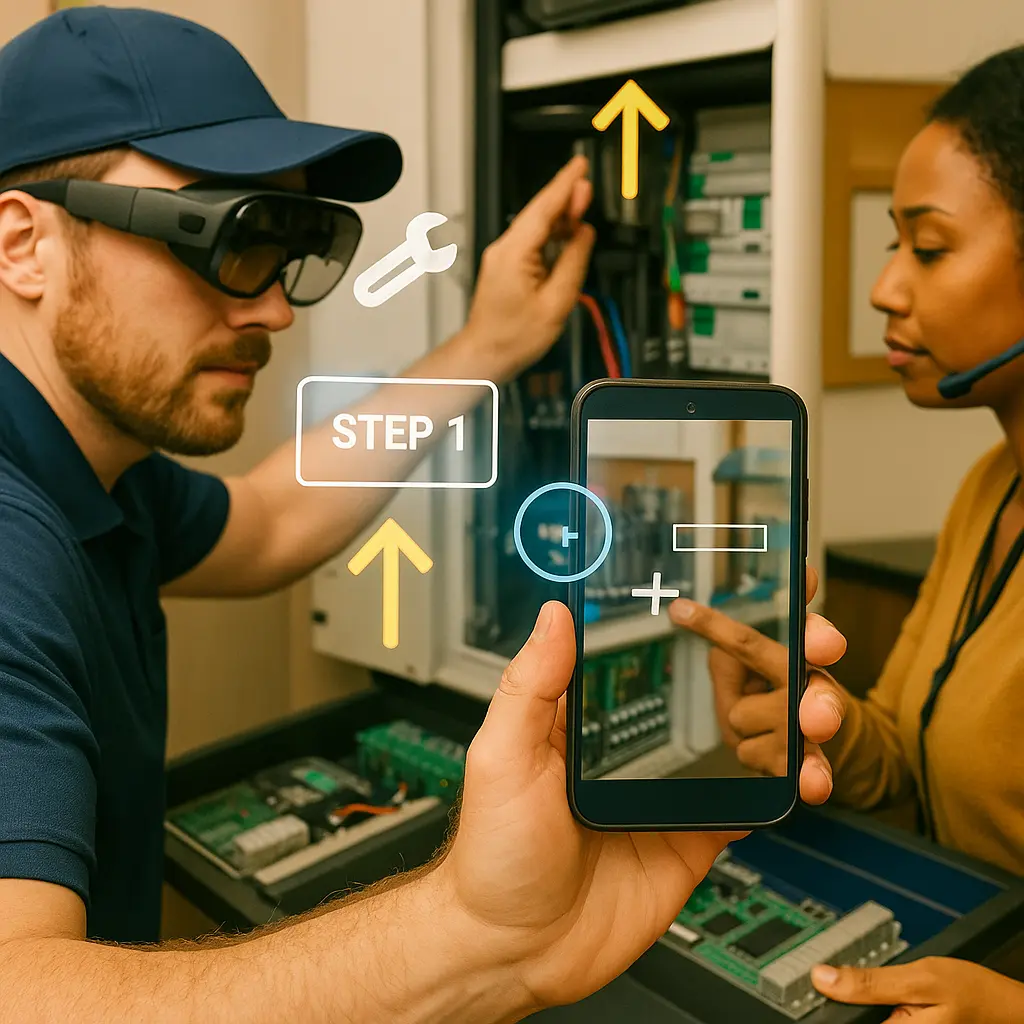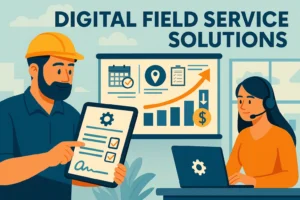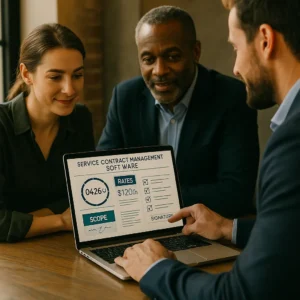Even brilliant technicians lose time when faced with unfamiliar situations: unacquainted gear, obscure fasteners, unclear manuals, or an uncommon fault code. Augmented Reality in Field Service (AR) eliminates guesswork. A tech simply points a phone or headset at the asset and receives overlays with the next step, the correct part, or live input from a remote expert. The result: quicker repairs, fewer unnecessary callbacks, and safer operations—without turning people into automatons.
You don’t need a moonshot to begin. AR is most effective when it enhances simple routines you already perform: task checklists, photos, and brief videos. Integrate AR into the steps that cause frequent mistakes, then scale up. With Shifton, you can trial the essentials for a full month at no cost, verify improvements on real visits, and make data-driven decisions.
Augmented Reality in Field Service impact on coverage & cost
Fundamentally, Augmented Reality in Field Service accomplishes three key tasks:
Guided work. On-device overlays indicate where to probe, loosen, or align. Steps unlock sequentially, ensuring safety is not overlooked.
See-what-I-see support. A remote expert annotates the video feed—using arrows, circles, numbers—enabling the tech to follow without lengthy phone calls.
Real-time recognition. Labels, ports, and parts are identified on camera to avoid mix-ups and unnecessary return trips.
This isn’t sci-fi. It’s simply a more intelligent way to provide the same checklists and shared knowledge you already rely on—right at the job site.
Why teams face delays
New equipment, rare faults, and turnover all cause hesitation. A technician opens a panel and wastes ten minutes just figuring things out. Another swaps the wrong cartridge and needs to return. Dispatch handles calls seeking help while customers wait. Augmented Reality in Field Service transforms those fragile steps into straightforward, visual prompts. This helps people work confidently and managers observe consistent results across teams.
Where to implement AR first
Installation steps with high error rates. If an overtightened fitting repeatedly fails, incorporate a torque overlay with a brief animation.
Commissioning and calibration. Display the ports to connect, sequence of operations, and target readings in view.
Rare or high-risk tasks. Confined space preparation, lockout/tagout, gas checks—AR can ensure proper sequence and photo verification.
Parts and van-stock ID. Rapidly confirm the correct cartridge, filter, or valve using camera recognition.
Onboarding. Pair a new hire with remote “eyes” so they gain hands-on experience without slowing operations.
What effective implementation looks like technically
To ensure that Augmented Reality in Field Service is helpful daily—not just in a demo—the system should be pragmatic:
Phone-first with optional headsets. Avoid forcing new hardware on day one. A capable smartphone offers 80% of the value.
Offline support. Cache guides and models so remote sites can function; sync when the signal returns.
Effortless capture. Automatically save photos and short clips into the work order; no need to hunt for files later.
One source of truth. AR steps are linked to the same job templates your technicians already utilize.
Analytics. Monitor time per step, causes of repeat visits, and where experts are engaged.
The business case: small changes, big impact
Fewer repeat visits. Clear overlays + correct parts reduce “back tomorrow” cycles.
Faster time to proficiency. New technicians become productive weeks earlier.
Safer days. Visual lockout, PPE checks, and hazard prompts prevent shortcuts.
Improved customer confidence. Clients can literally see the procedure and sign off with evidence.
When Augmented Reality in Field Service saves even ten minutes per complex task and reduces a few repeats each week, it quickly justifies its cost.
A rollout plan that won’t disrupt operations
Select one asset and one key performance indicator (KPI). Example: reduce repeat visits for model X by 30%.
Map the challenging steps. Consult with senior technicians on error-prone areas; develop short, visual guides for those steps only.
Begin phone-first. Avoid headsets initially. Make sure guides are functional offline.
Include remote assistance. Allow one expert to support multiple crews, annotating live video when necessary.
Capture evidence automatically. Photos and clips save to the work order with timestamps.
Review weekly. Did repeat visits and time-on-task decrease? If not, refine the guide—not the workforce.
Scale. Add more assets and tasks after the initial use case is effective.
Need a secure space to trial this? Create your workspace here: Registration. Prefer a guided walk-through with your scenarios? Book a session here: Book a Demo. Require the comprehensive scheduling and routing framework with AR? Begin here: Field Service Management.
The core cycle with AR in the field
Plan → route → execute → adjust → record → review—the same operational cycle, just more consistent.
Plan. The job template includes AR instructions for high-risk components.
Route. Skills and parts are aligned so the correct technician arrives prepared.
Execute. Overlays and remote annotations ensure the hands-on work is straightforward.
Adjust. If something changes, the expert revises the guide once for everyone.
Record. Photos and short clips are automatically linked to the job.
Review. Managers observe where time was expended and which steps caused issues.
Run that cycle for two weeks and you’ll see improvements: faster repairs, fewer calls to dispatch, more confident teams.
Training with Augmented Reality in Field Service
Traditional training is heavy: lengthy classes, thick PDFs, and poor retention. Augmented Reality in Field Service revolutionizes it:
Micro-lessons in context. A 30-second animation exactly where the hand needs to be.
Progress gates. Subsequent steps unlock only after capturing a required photo or reading.
Shadow less, learn more. Remote experts support multiple apprentices simultaneously.
The objective isn’t flashy content. It’s dependable muscle memory instilled through concise, clear prompts.
Troubleshooting with Augmented Reality in Field Service
When a fault arises, speed and certainty are crucial. AR enables you to:
Verify the symptom. Overlay expected versus actual readings.
Eliminate common causes. Quick checks with visual cues save time spent guessing.
Call an expert with context. They perceive what you see and suggest the next action directly on the screen.
Thus, Augmented Reality in Field Service turns complex problems into routine tasks.
Privacy and safety, without drama
Good AR honours individuals. Track only during work, store only what’s necessary, and allow techs to view and amend the record. Implement a simple policy: on-job video is for support and validation, not surveillance. When teams feel valued, adoption becomes lasting.
Metrics that validate the value
First-visit fix rate: +5–10 points on focused assets.
Mean time-to-repair: Reduced by 10–20% on guided tasks.
New-hire time to independence: Significantly quicker.
Repeat-visit rate: Decreased as parts and steps are verified in-view.
Safety incidents on targeted tasks: Fewer near-misses when sequences are enforced.
Buy vs. build
In-house AR pilots often falter with content maintenance, device support, and offline sync challenges. A platform that integrates Augmented Reality in Field Service into schedules, parts, and reports solves these—keeping guides organized in one place for ongoing updating.
Why Shifton is a pragmatic solution
Shifton integrates AR guides and remote assistance with the jobs, routes, skills, and parts you currently manage. It’s prioritised for phones, functional offline, and designed for quick, measurable results. The basic plan is free for the first month—execute a focused pilot and make decisions based on outcomes, not hype.
Start now: Registration
Prefer a live tour: Book a Demo
View the comprehensive framework: Field Service Management
Augmented Reality in Field Service performs optimally when it’s mundane—in a constructive manner. Brief prompts, clean overlays, and quick expert annotations that maintain workflow and keep clients reassured.
Augmented Reality in Field Service setup: roles, training, audits
Over-engineering content. Elaborate 3D is unnecessary if technicians require a one-screen animation.
Neglecting offline capability. Remote locations expose inadequate tools. Cache guides locally.
Disregarding parts. Visual steps are ineffective if the correct cartridge isn't available.
Excessive tracking. Protect privacy; concentrate on support, not surveillance.
Bypassing reviews. Adapt the guide based on new insights; don’t blame the individual.
FAQ
What equipment is necessary to begin?
A smartphone is sufficient.
Start with phone-first, then introduce headsets for tasks requiring both hands. Ensure Augmented Reality in Field Service guides operate offline and synchronise efficiently.
Will AR slow down technicians?
Not if it’s concise and specific.
Use 20-40 second clips and straightforward overlays. Most technicians accelerate after a few tasks as hesitance diminishes.
Can remote experts genuinely assist multiple teams simultaneously?
Yes.
With “see-what-I-see” sessions, one expert can annotate two or three jobs in parallel, intervening only during complicated steps.
How is success measured?
Monitor four metrics.
First-visit fix rate, mean time to repair, repeat-visit rate, and near-miss incidents on guided tasks. If these metrics improve, the rollout is successful.
Is AR only useful for complex equipment?
No.
Even simple installations benefit from visual torque cues, port identification, and final photo proof. Augmented Reality in Field Service is about easing difficulties, not showcasing technology. Ready to grant every technician a composed, visual co-pilot? Initiate a pilot with one asset and one KPI. Utilise the first month—free on the basic plan—to demonstrate tangible improvements and build your case to expand.

 English (US)
English (US)  English (GB)
English (GB)  English (CA)
English (CA)  English (AU)
English (AU)  English (NZ)
English (NZ)  English (ZA)
English (ZA)  Español (ES)
Español (ES)  Español (MX)
Español (MX)  Español (AR)
Español (AR)  Português (BR)
Português (BR)  Português (PT)
Português (PT)  Deutsch (DE)
Deutsch (DE)  Deutsch (AT)
Deutsch (AT)  Français (FR)
Français (FR)  Français (BE)
Français (BE)  Français (CA)
Français (CA)  Italiano
Italiano  日本語
日本語  中文
中文  हिन्दी
हिन्दी  עברית
עברית  العربية
العربية  한국어
한국어  Nederlands
Nederlands  Polski
Polski  Türkçe
Türkçe  Українська
Українська  Русский
Русский  Magyar
Magyar  Română
Română  Čeština
Čeština  Български
Български  Ελληνικά
Ελληνικά  Svenska
Svenska  Dansk
Dansk  Norsk
Norsk  Suomi
Suomi  Bahasa
Bahasa  Tiếng Việt
Tiếng Việt  Tagalog
Tagalog  ไทย
ไทย  Latviešu
Latviešu  Lietuvių
Lietuvių  Eesti
Eesti  Slovenčina
Slovenčina  Slovenščina
Slovenščina  Hrvatski
Hrvatski  Македонски
Македонски  Қазақ
Қазақ  Azərbaycan
Azərbaycan  বাংলা
বাংলা 

